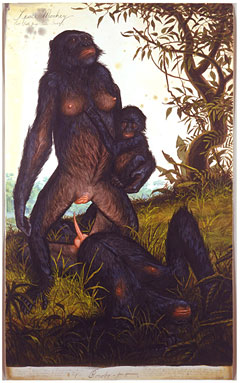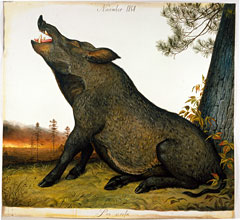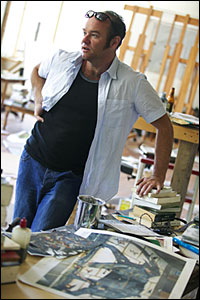
Walton Ford.
Photo: Jason Houston
They, whoever the hell they are, say that great paintings work on many levels, and on the first, visceral level, a Walton Ford painting is gorgeous. Because his paintings are done on a large scale, it’s an in-your-face gorgeousness: You can’t miss the luster on a bison’s hoof, the plump pinkness of a zebra’s tongue, the detailed fur of a lion. I was a bit shocked to discover that Ford works in watercolor, a medium I’d always associated with washed-out seascapes. But this artist, who exudes a burly, masculine energy in person, does for watercolor what a chef like Jamie Oliver does for an unsung vegetable. Talent can take an underrated thing, be it pastels or peas, and make it robust, even sublime.
On the next level, Ford wants you to get beyond gorgeous and use your head. His paintings may look like classic natural history images; he picked watercolor to follow in the style of naturalist painters likes John James Audubon, to whom he is often compared. But upon closer inspection, you realize Ford’s stuff is not decoration for a sportsman’s den, but heady, allegorical work.
Take a fairly recent painting, Le Jardin, which shows a bison being attacked by wolves. The large triptych is set in a manicured French garden, making it jarring and nightmarish. The yellow-eyed wolves are white, which really makes the blood pop out. Here, nature is out of control in a controlled “natural” setting. But not just any nature: this is the savage stuff that embodies the myth of the American cowboy West. The bison, which looms in all-American largeness at center stage, is drooling and urinating.

To me, Ford’s work is like a Coen brothers film: compelling, smart, violent, and absurd, a send-up that resonates in a thrilling, uneasy way. Although he rejects the label “environmental,” I’ve decided to draft him onto our team: his work deals exclusively with nature, and often with its destruction.
Given his acclaim — he’s a Guggenheim Fellow whose work is in the collections of the Whitney Museum and MoMA, and he’s represented by the esteemed Paul Kasmin Gallery — Ford could work anywhere in the world, but set up his cluttered studio in my small New England town of Great Barrington, Mass. He relocated to the Berkshires with his wife, artist Julie Jones, and his two kids 10 years ago, after his New York neighborhood became too hip. The move isn’t surprising: Ford is a contrarian who likes to run against the tide. How else to explain the choice of realism, watercolors, and allegory at a time when Americans can’t get enough of Thomas Kinkade’s mass-produced impressionist cottages.
At 46, Ford is chicly bald, artistically intense, and pleasantly chatty all at once. If you come across him (which is easy to do at one of the coffee shops in Great Barrington) or one of his paintings, you might as well sit back, because you’re going to be there for a while. As an artist and person, he is quite a storyteller.
What have you been working on?
The last major piece that I did was part of a series that is ongoing. I was interested in contrasting two different kinds of visions of nature that we have. One of the pieces in the series is a bison being attacked by wolves in this garden.
Le Jardin?
Le Jardin. That painting has to do with this idea of husbanding nature to the degree of making it into a work of art, which the French excel at, for example, with their gardens and with their food and with the way the women look and just everything. The way that they approach nature is to husband it to a point where it is so refined that it becomes something that has more to do with the culture than anything in the natural world. I remember in Normandy having a fish soup that was so reduced it was like a tomato soup. There’s no fish in it anymore — it’s just a super-refined dish. I was interested in contrasting that with the culture of nature here in America, where we try to celebrate a sort of savagery. Our walled garden is a national park that has some sort of predatory-prey relationship. Yellowstone is a walled garden; so is Versailles.
But they’re very different.
In the image that I came up with you get a dissonance that makes you realize how different these concepts are.
Do you think one’s better than the other?
No, I don’t, actually, and at this point, they’re both artificial. One of the things I say over and over again, which doesn’t always seem to get through, is that the paintings aren’t really about these animals but about the lens that people look through to see the animal. That cultural lens that we have informs our attitudes toward nature, and I want to have my animals act that out. I’m not interested in necessarily moaning about extinction or stuff, even though I use extinct animals. That urge to use extinct animals has more to do with the fact that these extinctions occur at times of great interaction, in a funny way, between man and nature, and that point of interaction is what I’m more interested in than the actual behavior of the animal.
You’ve been called environmental. How do you feel about that?
I do have those beliefs, and I think it was madness that Bush didn’t sign the Kyoto treaty. At the same time, I don’t necessarily want to make art about that. As important as those issues are, it has less to do with my project. I am interested in seeing, say, for an example, an extinct animal. I am dissatisfied with the renderings I see of things like passenger pigeons and Carolina parakeets. I don’t like Audubon’s painting of passenger pigeons — there’s two of them making love on a branch. These things filled the sky like weather systems! It’s a ridiculous painting; it has nothing to do with the biology of these animals.

Shelter Island, 2006. Watercolor, gouache, ink, and pencil on paper. 32 1/2 x 50 inches.
Courtesy of the artist and Paul Kasmin Gallery, N.Y. Photo by Christopher Burke.
Can we talk for a second about your complex relationship with John James Audubon?
Yeah, yeah, we can.
You’ve been called Audubon on Viagra.
I like that kind of stuff because it’s interesting and it’s funny. But Audubon is the perfect example of why I’m making the work. He’s the intersection between culture and nature that is really interesting. He does come out of that 19th century Romantic tradition. The most interesting paintings he did really tapped into that. He loves to paint animals in traps, he loves to paint animals in battle, he likes to paint animals making love in some kind of cooing, billing way, and he likes to reinforce clichés about animals like the doves are kissing and the hawk is rapacious and the male, the bird, even if it is a matriarchal kind of relationship, is ascendant. And those are interesting things to explore — his narrative modes and his way of producing those dramatic pictures that he did. There’s a red-tailed hawk with the claw going right into the rabbit’s eye and the blood is dripping out and it’s absolutely horrible. When you’re a little kid, you can’t stop staring at it, and that was the kind of little kid I was. The morbid aspect of Audubon interested me a lot when I was little because it wasn’t the popular images.
You’ve been critical of how many specimens he collected.
Well, he didn’t collect specimens to paint — everybody loves to say that. He collected specimens professionally, and he also just shot things off of boats to watch them drop into the water. He didn’t care. All you’ve got to do is read the Missouri journals or something. He fires on coyotes on the bank and wounds them and then watches them shake themselves as they run away, to try to get the pellets out. It’s just all in a good day’s fun.
What about the theory that he was just a man of his time?
Yeah, that’s fine, except so were Thoreau and Emerson and all these other guys. There were always different ways of looking at things.
You deal with the theme of repulsion and attraction — you show animals committing acts of violence and sexual acts. Are you asking us not to look away from the reality of nature?
Well, partly that, and partly the animals are acting like people. Partly it’s the way that all the animals in Alice in Wonderland are rude. They are all presumptuous and rude and outrageous and idiotic, and they sort of anticipate the Marx Brothers in the way that they act, sort of ridiculous, overturning of convention all the time. Sometimes it’s just fun to make the animals do things like that.
To show us our own behavior?

Space Monkey, 2001. Watercolor, gouache, ink, and pencil on paper. 59 1/2 x 36 inches.
Courtesy of the artist and Paul Kasmin Gallery, N.Y. Photo by Adam Reich.
Yeah, or to shuck off a cliché. There’s a blatantly pornographic image of chimpanzees that I made that is telling a sort of biological truth. It shows a female chimp with her genitals all swollen and a male chimp is on the ground. It’s a bonobo, actually, and they’re the most sexual of animals, but it’s a matriarchy and the matriarchy is enforced by promiscuous behavior on the behalf of the females who blur lines of paternity by having so many different lovers that the males no longer have any political power.
These female chimps figured out that if they had multiple partners, nobody could figure out whose kid is their kid and therefore can’t kill their rival’s offspring. My feeling about it was that until you had these female primatologists out in the field, you never would have found this out. The bonobo was an invention of feminism on some level. So, the painting is called Space Monkey, which is a Patti Smith song, because I’m thinking Patti Smith is the reason these monkeys were found, on some weird level, right? It’s not just because I feel like painting a hard-on on a monkey. I had a thesis that I was trying to work out in my own head and all the paintings that have that kind of behavior had a thesis like that. It’s not like this would be a better picture if one of the animals is fucking the other one — they’ve got to have a pretty good reason.
There’s marginalia in your paintings — it’s your handwriting. Is that a legend to help people unlock what’s in the painting?
Yeah, definitely. The marginalia is something that you see in those 19th century explorer-artist guys all the time because they’re often addressing information either to themselves or to the person who’s going to actually make the prints that will then be in the book that these guys are all planning. For example, with Audubon, he has tons of marginalia in all his watercolors, and they’ll say things like “finish this background better” or “the eye of this bird is more silvery than yellow” or “the beak is thinner than this.”
Field notes?
Field notes to both himself and to his publisher, so that they get the print right. Almost none of these images were intended for publication. It was always intended to be altered and put into a book in some form, either as lithographs later or etchings or end up as plates in a book that was to sell. You wouldn’t bother going out in 1840 on the Columbia River and risking your life unless there was some sort of reward. [George] Catlin and [Karl] Bodmer and Audubon — they all went out there with an eye toward publication and later fame and fortune, and celebrity.

Do you think enough artists today are doing content and allegory?
No. I think that we’ve lost the ability to read allegory. People look at my paintings and there’s a tremendous amount of information in them and they say, “What’s it about?” I’m like, “Goddamn, I’ve given you everything! I’ve thrown the freaking kitchen sink in it!” Even though it’s obscure or cryptic, the code is in the picture. Nobody even attempts to decode it on their own. Not no one — plenty of art critics do.
Sometimes you add social-political commentary.
Sort of. I would never make an animal and say, “That’s George Bush” or “This animal is the United States of America.” It’s more like the animals stand for more general ideas.
Tell me about the starlings that keep showing up in your work. They’re an invasive species.
They’re an invasive species. They can spread wherever there are towns. They’re related to mynah birds. They’re interesting. They’re very smart, they’re very loud and aggressive. I use them like a self-portrait of what it feels like when I’m in third-world countries, traveling. My sort of cluelessness and my greed — the way when you go to Katmandu there has to be a Pizza Hut. You don’t eat the dal bhat. You do what starlings do: you make a nest, a big messy invasive nest in the eaves of the building, instead of kind of fitting into the landscape.
One of your paintings shows starlings handing out Hershey’s Kisses.
Yeah, yeah. I don’t know how well that works, but it was cute, that image.
How often do you get out of your studio and into the woods?

November 1864, 2005. Watercolor, gouache, ink, and pencil on paper. 60 3/4 x 65 inches.
Courtesy of the artist and Paul Kasmin Gallery, N.Y. Photo by Adam Reich.
Well, I backpack, and at least two or three times a year I go on a long-distance thing and I walk in the woods. I’ll do loops of six and eight and 12 miles a few times a week.
Do you ever bring your sketchbook?
I never bring my sketchbook [laughs].
What’s next for you?
It’s hard to say, but I don’t think I’ve exhausted the possibilities yet. I’ve only made, say, three or four of these images of all hell breaking loose in some formal setting. There’s an earlier painting I did of Audubon’s mother’s monkey strangling a parrot in a nice garden in Nantes, where he grew up. So I’ve done about three of these gardens — formal gardens with exotics going berserk in them. I think that’s a theme that I want to do more. I don’t know. More could pop into my head.
Thanks for talking to me.
Don’t get me started.


